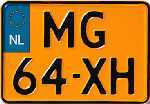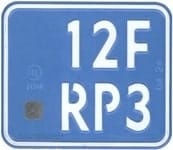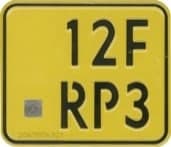Subjects:
- History
- Types of license plates
History:
Two years after the first car appeared on the road in the Netherlands, the first number plates (then still called driving permits) were mounted on a number of cars in 1898. This made the Netherlands the first country in the world to introduce a national number plate.
The first set of license plates ran from 1 to 14, skipping the crazy number 11. Documents show that this very first set of numbers had progressed to 8 on August 1899, 168. Seven years later, on January 15, 1906, the last driving license was finally issued (number 2065). From now on, the car and driver had to have both a driver's license and a proof of number. This license plate, say the new license plate, was set up according to a provincial system. Each province has its own letter. This system functioned until after the Second World War.
The first license plate numbers were also linked to a province, because the motorists usually stayed within the province in the beginning. But traffic increasingly went beyond the provincial border and it was decided to arrange the administration nationally, at a central location. That was the origin of the RDW (then still the Rijksdienst voor het Wegverkeer). It was not until 1951 that the license plate system – as we know it today – was introduced with the combination of three times two letters or two numbers.
The Dutch registration numbers are made up in pairs from a combination of 2 letters and 4 numbers or 4 letters and 2 numbers. Before 1951 extensive research was done to determine which combination of letters and numbers would be the best. A lot of visual possibilities have been tested on the criterion of recognizability. The number plate as we know it today, which is divided into three groups of two characters, came out as the clearest and most recognizable. This is very important, because in some cases a vehicle owner must be able to identify quickly and easily.
Until 1951, the issue and registration of vehicle documents was provided by the Provincial Executive of the provinces. The number cards were personal and were issued 'for life' (of the holder). Each province had one or two fixed letters followed by up to five numbers. Below you can see which provinces had which letters:
A = Groningen
GZ = North Holland
B = Friesland
H = South Holland
D = Drenthe
HZ = South Holland
E = Overijssel
K = Zeeland
M = Gelderland
N = North Brabant
L = Utrecht
P = Limburg
G = North Holland
R = Departments
The new series started with placing the two letters in front of the four numbers. The first license plate issued was ND-00-01.
In 1965 the two letters came after the numbers. The first registration number was 00-01-AD. In 1973 the first license plate was issued with the letters between the numbers. That was 00-AD-01. The letter combinations SA and SS were not used in these three series, because they reminded too much of the Second World War. When these three series were finished, we started with the license plates with four letters and two numbers. The first registration (DB-01-BB) was issued in October 1978.
After the completion of this series, it was time for yet another combination. The letters for the numbers. DB-BB-01 was the first issue and was issued in September 1991.
From June 1999 the numbers came before the letters. The first number was 01-DB-BB.
There are no vowels in the current series of four letters and two numbers. This is done to avoid unwanted word formation. Also, the letters C and Q are not used, because these letters look too much like a zero.
Types of license plates:
License plate for passenger cars, commercial vehicles and trailers
The vehicle registration plate bears the EU symbol with the NL symbol included in the foil. The size is 52 by 11 centimeters. No more than two number plates may be provided per vehicle (one for trailers). The number plates must be fully visible. Therefore, no couplings (towing hooks) or other things may obstruct the free view of the plate. This registration plate is for trailers with a maximum authorized mass of more than 750 kg.

White license plate for trailers, caravans and bicycle carriers
The white number plate is for towed equipment such as trailers and caravans, whose unladen weight plus maximum payload is less than 751 kg, and for bicycle carriers. The plate has no EU symbol and NL sign. This license plate can be supplied indefinitely. Objects that obscure the view of a number plate must also have a white number plate.

Motorcycle license plate
The motorcycle registration plate bears the EU symbol with the NL sign included in the foil. The number plate has a size of 21 x 14,3 cm. One new license plate is issued per motorcycle.

moped license plate
Since 1 September 2005, mopeds and light mopeds also have their own number plate. The license plate has a horizontal version of 14,5 x 12,5 cm and a standing version of 10 x 17,5 cm.
The registration plate for mopeds has a yellow background with black characters, that of mopeds has a light blue background with white characters. The number plate does not have an EU logo, but it does have a hologram. One license plate is provided per moped.
The moped registration plate is used for all vehicles that fall under the definition of moped, including mopeds, microcars, bicycles with an auxiliary engine and electric scooters.
Just like for passenger cars, there are a number of special number plates for mopeds. These have the same dimensions as the other moped license plates, but have a different colour:
- Dealer registration plate (green background with black characters) ao for
mopeds in company stock that require a test drive. - Number plate for trailers (white background with black characters)
for trailers behind mopeds - Temporary license plate (white background with black characters)
- Seven-day registration plate (white background with black characters)
- One-day license plate (white background with black characters)
- Export license plate (white background with black characters)
The export license plate and one-day license plate do not have to be provided by the recognized license plate manufacturer, but can also be made in-house.


Temporary license plate
Only available after loss or theft of the number plates. This number plate is made without the EU emblem and the NL sign and has a limited period of validity. There is a month number on the left of the license plate. The license plate is valid up to and including that month. If one of the two number plates is missing or stolen, the vehicle must be fitted with a temporary number plate at the front and rear.

Export license plate
Vehicles exported abroad must carry white export registration plates with black characters when they leave the country on the road. The export registration number is provided on the condition that the vehicle is still MOT approved.

Dealer registration plate
Only available for recognized companies in the car or motorcycle industry. The new license plate for recognized companies in the car or motorcycle industry is in light green with black letters and numbers. These plates are used, among other things, to enable customers to take test drives and are only available to recognized companies in the car or motorcycle industry.

Taxi license plate
Since 1 December 2000, all vehicles used for taxi transport are obliged to carry the blue taxi registration plates. The reason for this was to combat illegal taxi transport and to create clarity for taxi users. If the vehicle is not equipped with these plates, no taxi transport may be carried out with the vehicle in question.

Dark blue license plate
The dark blue registration plate is intended for historic vehicles with a “first admission date” before January 1, 1978 and whose registration number consists of 2 groups of 2 digits and 1 group of 2 letters.

Special license plates
There are special license plates for certain groups of people. Think of the Royal House with AA or diplomats and embassies with CD. These are yellow and have a black frame and a blue area containing the EU symbol and the NL symbol.
American license plate
The small, American 18:2 license plate is only intended for vehicles with a statement on the registration that this license plate is allowed. A condition for carrying the small plate is that this is stated on the registration certificate.
Source: rdw.nl
